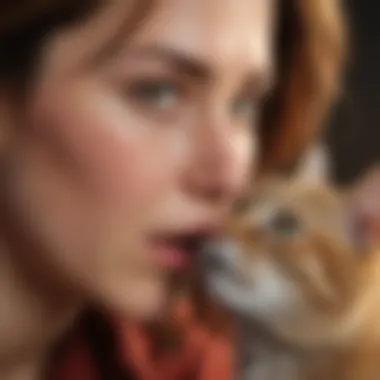Understanding Rapid Breathing in Cats: Causes and Implications


Intro
Fast breathing in cats can be a perplexing issue for pet owners. Understanding this phenomenon is crucial for anyone who cares for these animals. A cat's rapid breathing might indicate an underlying health problem or could simply reflect normal physiological responses to stress or excitement. This article will discuss key factors influencing a cat's breathing rate and how to interpret these changes within various contexts.
Understanding Your Pet
Breed Traits
Different cat breeds have distinctive traits that can influence their breathing patterns. For instance, flat-faced breeds like the Persian or the Exotic Shorthair might traditionally exhibit respiratory challenges due to their anatomical structure. Conversely, breeds such as the Abyssinian may show an increased respiratory rate when excited. Knowing your cat's breed can aid in understanding what is typical and what might be concerning regarding rapid breathing.
Common Temperaments
A cat's temperament can also play a role in its breathing. Some felines are more anxious or hyperactive, leading to faster breathing. Stressors such as loud noises or changes in their environment can trigger this response. Monitoring your cat's behavior in relation to its breathing is important. Is it calm and relaxed, or does it seem agitated? Observing these nuances will help you gauge their well-being.
Special Needs
Certain cats have special needs that may affect their respiratory health. Older cats or those with pre-existing conditions like asthma can be more prone to rapid breathing episodes. Regular veterinary check-ups are essential for these cats to manage their health effectively. Always consult your veterinarian if you notice significant changes in your cat's normal breathing patterns.
Pet Care Essentials
Nutrition and Feeding Guidelines
Providing a balanced diet is vital for maintaining your cat's overall health. Poor nutrition can lead to obesity, which strains the respiratory system. Choosing high-quality cat food that meets the specific needs of your pet can help optimize its health. Consult with your veterinarian to determine the best nutrition strategy for your pet.
Grooming Tips and Techniques
Regular grooming helps maintain fur and skin health. Long-haired breeds require more frequent grooming to prevent matting, which can cause discomfort and stress. A stressed cat may breathe rapidly. Ensure your grooming routine is gentle and calming to prevent anxiety.
Health and Wellness
Routine health check-ups are crucial to detect any potential respiratory issues. Vaccination and parasite prevention are also key components of maintaining a healthy environment for your cat. Pay attention to signs of distress, including persistent rapid breathing, coughing, or lethargy, as these may indicate health concerns.
Training and Behavior
Basic Training Techniques
Training your cat can help reduce anxiety and establish a routine, which in turn supports healthy breathing. Use positive reinforcement to encourage good behavior. This method not only strengthens your bond but may also lead to reduced stress for your cat.
Behavioral Problems and Solutions
Addressing behavioral concerns promptly is essential. Cats that feel threatened or anxious may exhibit rapid breathing as a response. Identifying triggers and implementing strategies to minimize stress can be beneficial. If behavioral issues persist, consider consulting with a professional animal behaviorist.
Mental Stimulation Activities
Engaging your cat's mind can alleviate stress. Providing toys that challenge and entertain will prevent boredom and its associated anxiety. Simple activities like puzzle feeders or feather wands can keep your cat active and help regulate breathing.
Engaging with Your Pet
Interactive Games and Toys
Interactive play is beneficial for both you and your cat. It not only fosters a happy environment but also helps to keep your cat's mind engaged. Regular play can help reduce anxious breathing by providing an outlet for energy.
Safe Outdoor Activities
If your cat enjoys fresh air, consider supervised outdoor activities. A secure harness and leash can allow your cat to explore the outside world safely. Natural environments can sometimes reduce anxiety levels, subsequently promoting a calmer breathing rate.
Family-Friendly Pet Interactions
Encouraging positive interactions with family members can help your cat feel secure and loved. Children should be taught gentle ways to play and interact with pets. A stable and loving environment can help mitigate stress, which is important for healthy breathing.


Pet Adoption and Integration
Choosing the Right Pet for Your Lifestyle
When considering cat adoption, evaluate whether your lifestyle aligns with the needs of the cat. Some breeds require more exercise and social interaction than others. Make an informed decision to ensure a good match and reduce future stress and anxiety.
Preparing Your Home for a New Pet
Creating a welcoming space for your new feline friend is key. Ensure that your home is safe and has spaces where they can feel secure. This may help prevent anxiety and its associated respiratory symptoms.
Tips for Smooth Prolusion
When integrating a new cat into your home, introduce them slowly to reduce stress. Allow your new and existing pets to acclimatize to each other gradually. Proper introductions can lead to a harmonious household, which ultimately contributes to healthy breathing patterns.
Rapid breathing in cats should not be ignored. It is important to observe your pet's behavior and seek veterinary advice when needed. Making informed decisions about their care can ensure a healthy and happy life for your feline friend.
Prolusion to Cat Breathing Patterns
Breathing patterns in cats are critical indicators of their health and wellbeing. Understanding these patterns can help pet owners identify when their cat is experiencing distress. This article will delve into the nuances of cat breathing techniques, with a specific focus on normal and rapid breathing.
Understanding Normal Breathing Rates
To gauge feline health, it is essential to know what normal cat breathing looks like. Typically, a healthy cat breathes between 20 to 30 times per minute when resting. This rate can vary based on several factors including age, breed, and overall activity levels. A swift way for owners to assess this is by simply observing the rise and fall of their cat's chest. When cats are in a relaxed state, breathing tends to be gentle and rhythmic.
Normal breathing rates may shift temporarily for reasons like exercise or mild excitement. During such situations, increased breathing can occur, but it usually normalizes quickly afterward. Understanding these normal rates allows owners to better recognize what might indicate a health problem later.
Defining Rapid Breathing in Cats
Rapid breathing, medically known as tachypnea, refers to an increased respiratory rate. For cats, this can mean breathing rates above 30 breaths per minute while at rest. It often serves as a signal that something may be wrong. Rapid breathing can be caused by various physiological factors, ranging from excitement to significant health conditions.
In some cases, a cat may breathe rapidly due to stress or pain. Other instances may point to serious underlying issues related to respiratory or cardiac health. It's essential for pet owners to distinguish between short-lived instances of rapid breathing and prolonged episodes that could require veterinary attention.
Rapid breathing in cats is not always a sign of panic. It can signify a range of conditions that need close observation.
Recognizing rapid breathing is the first step in addressing potential health issues. By learning more about what this means for their cat, owners can become proactive in their care and ensure timely intervention if required.
Physiological Factors Influencing Breathing
Understanding the physiological factors that influence a cat's breathing is crucial for any pet owner. These factors can help differentiate between normal and abnormal respiratory patterns. Importantly, recognizing how various stimuli affect breathing can inform how we approach our cats' health. Stress, activity levels, and the surrounding environment play inent roles in a cat's respiratory behavior. Thus, analyzing these elements can lead to better care and timely interventions when necessary.
Excitement and Stress Responses
Cats are sensitive creatures, and their breathing patterns can change significantly in response to excitement or stress. When a cat experiences a surge in emotional states, whether due to play, a new environment, or due to perceived threats, its body goes into a heightened state of alertness. This physiological response may include rapid breathing as the cat's system prepares to deal with what it perceives as a challenge or opportunity.
Understanding this reaction is key for cat owners, as it can happen suddenly. For example, during play, a cat may breathe faster as it chases a toy or engages with another cat. Similarly, a visit to the vet can result in increased heart rates and rapid breathing. The owner can observe and reassure the cat in these moments to help mitigate stress, thereby helping regulate breathing.
Changes in Activity Levels
Activity levels in cats significantly influence their breathing patterns. When cats are active, such as during play or indoor exploration, their metabolic rate increases. This elevation naturally leads to quicker and shallower breaths to meet the oxygen demand. It is essential to note that after periods of intense activity, cats may continue to breathe rapidly for a short duration before returning to a resting state.
Conversely, when cats are sedentary or asleep, their breathing tends to slow. Owners should keep an eye on transitions between active and resting states. If the rapid breathing continues or occurs without any known activity triggers, it may signal an underlying issue that requires attention. Regular observation of breathing in relation to activity can provide valuable insights into a cat's health and well-being.
Environmental Factors
Environmental elements can also significantly impact a cat’s breathing. Factors such as temperature, humidity, and air quality can either soothe or agitate a cat, influencing its respiratory patterns. For instance, excessively warm or humid conditions may lead to faster breathing as cats attempt to cool down. In contrast, a dry environment can make breathing more taxing.
Additionally, exposure to allergens or irritants such as smoke, strong odors, or different household chemicals may provoke rapid breathing or respiratory distress. Cat owners should remain vigilant about the surroundings, ensuring a clean and comfortable environment for their pets. Certain changes in the home, like introducing new cleaning products or moving to a different climate, might evoke unexpected respiratory responses in felines.
Addressing these physiological factors can significantly enhance a cat's overall health and comfort. Recognizing the root causes of rapid breathing adds to the understanding of feline behavior and physiology.
Health-Related Causes of Rapid Breathing


Understanding rapid breathing in cats is crucial for pet owners. This section highlights health-related causes that can lead to fast breathing, helping owners identify potential health concerns early. Knowing these causes enables timely veterinary intervention, improving overall feline health outcomes. Let's delve into various medical conditions that can result in rapid breathing, focusing on specific categories such as respiratory conditions, cardiac issues, and pain-related factors.
Respiratory Conditions
Asthma in Cats
Asthma in cats is a significant contributor to rapid breathing. This condition results in inflammation and narrowing of the airways, making it hard for a cat to breathe. The key characteristic of asthma is wheezing, along with the rapid breathing. This aspect makes asthma a critical focus in understanding feline respiratory issues.
Asthma often requires long-term management, which can involve medication and environmental changes. A unique feature of this condition is that certain allergens, like dust or pollen, can trigger asthma attacks. Addressing asthma quickly is essential to prevent severe respiratory distress in cats.
Respiratory Infections
Respiratory infections, which can include viral or bacterial infections, are another significant cause of rapid breathing in cats. The high characteristic of these infections is an increase in respiratory rate due to congestion and inflammation. This makes understanding respiratory infections vital for pet owners.
The unique feature of respiratory infections is their contagious nature, especially among cats in shelters or multi-cat households. These infections can lead to complications if not treated, so recognizing the signs early—like coughing, sneezing, or nasal discharge—is crucial in managing this condition effectively.
Cardiac Issues
Congestive Heart Failure
Congestive heart failure is a serious condition that can lead to rapid breathing. In this case, the heart struggles to pump blood efficiently, causing fluid buildup in the lungs. The key characteristic of this condition is the presence of difficulty breathing, which can happen during rest or exertion. This factor makes understanding congestive heart failure vital for cat owners.
One unique feature of congestive heart failure is that it may arise from chronic conditions, like high blood pressure. Early detection can significantly enhance a cat's quality of life and prolong survival. Recognizing signs like coughing or increased breathing rate is essential for potential interventions.
Cardiomyopathy
Cardiomyopathy is another common heart condition affecting cats, leading to rapid breathing. It involves the thickening of heart muscle, impacting its ability to pump blood effectively. The key characteristic here is that sudden changes in breathing patterns may indicate a worsening condition, making it crucial for owners to monitor their cats closely.
This condition can present unique challenges as it often shows no symptoms until it becomes severe. Regular veterinary check-ups help in early detection. Understanding cardiomyopathy can better equip owners to seek medical help when observing unusual breathing changes.
Pain and Discomfort
Rapid breathing can also result from pain and discomfort in cats. Pain can trigger a stress response, which increases respiratory rate. Recognizing signs of pain, such as changes in behavior or reluctance to move, is critical. Owners must be attentive to their cat’s cues, as they often hide their discomfort well.
Identifying pain sources can involve observing changes in body posture, vocalization, or grooming habits. Addressing pain can significantly improve a cat’s overall health and reduce episodes of rapid breathing, highlighting the importance of pain management in feline care.
Recognizing Signs of Respiratory Distress
Recognizing signs of respiratory distress is a crucial element in understanding your cat's health. Cats can exhibit various symptoms indicating trouble with breathing. By being mindful of these signs, a pet owner can act quickly, ensuring better outcomes for their feline companions.
When observing your cat, specific indicators can reveal whether a visit to the vet is necessary. Understanding these signs can assist pet owners in differentiating between normal behavior and potential health issues. Effective identification plays a vital role in maintaining your cat's overall well-being.
Observational Indicators
Open-Mouth Breathing
Open-mouth breathing is an alarming sign in cats. Unlike dogs, cats typically do not breathe through their mouths. The presence of open-mouth breathing is a key characteristic indicating distress. It suggests that the cat may be struggling to get adequate air, which can be a response to various health issues, such as respiratory or cardiac concerns.
The unique aspect of open-mouth breathing lies in its intensity. It showcases an immediate need for attention since the cat is likely unable to breathe comfortably. Recognizing this can help pet owners take action swiftly. The advantage of acknowledging this symptom directly impacts the timeliness of veterinary care. This leads to prompt interventions that could be life-saving.
Prolonged Rapid Breathing
Prolonged rapid breathing is another significant indicator of respiratory distress. It involves an increased breathing rate over an extended period, which is often accompanied by signs of anxiety or discomfort. This characteristic can signify ongoing issues which may need further investigation.
The unique feature of prolonged rapid breathing is its persistence. It sets it apart from temporary symptoms triggered by stress or excitement. Observing this can guide pet owners to consider a more profound health problem. Understanding prolonged rapid breathing aids in diagnosing underlying conditions. If noted, it is beneficial to contact a veterinary professional for advice.
Behavioral Changes
Apathy or Lethargy
Apathy or lethargy in cats is a substantial behavioral change. It refers to a marked decrease in energy or interest in normal activities. This lack of responsiveness can indicate that a cat may not feel well. It is an important consideration for any pet owner, as it often follows episodes of discomfort, including rapid breathing.


The main characteristic of apathy is the noticeable change in activity level. A normally energetic cat exhibiting a lack of engagement with its environment should raise a red flag. Recognizing this can prompt a pet owner to seek veterinary input. The advantage of identifying this symptom is the potential to uncover a broader health issue early on.
Withdrawal from Activity
Withdrawal from activity can significantly affect a cat's behavior. It may manifest as isolation or disinterest in playing or interacting with family members. This could signal that the cat is not well and could be linked to respiratory issues.
The key characteristic of withdrawal is its clear deviation from the cat's typical behavior. When you notice a cat pulling away, it is often a signal of distress. Recognizing this behavior can help you understand that your feline might be experiencing pain, discomfort, or even illness. The unique feature is that it often appears alongside other symptoms like rapid breathing, amplifying the concern.
Being observant of your cat's behavior and breathing patterns can lead to timely medical care. Your awareness significantly contributes to the overall health of your pet.
Evaluating the Context of Rapid Breathing
Understanding rapid breathing in cats requires a careful examination of the context in which this behavior occurs. Evaluating the surrounding circumstances is essential, as it helps in discerning whether the rapid breathing is a normal physiological response or an indication of a potential health problem. Feline breathing rates can fluctuate due to several factors, making it crucial for pet owners to assess the situation holistically.
Short-Term vs Long-Term Breathing Changes
When observing rapid breathing, one must differentiate between short-term and long-term changes. Short-term rapid breathing may happen in response to specific stimuli, such as excitement from play or stress from loud noises. In such cases, the cat's respiratory rate often normalizes once the triggering factor is removed. This temporary acceleration typically does not indicate serious health issues.
Conversely, long-term changes in breathing patterns can signify persistent underlying health conditions. If a cat consistently exhibits rapid breathing over days or weeks, it warrants immediate attention. Chronic rapid breathing can link to severe respiratory or cardiac problems. Pet owners should keep track of their pet’s breathing patterns and discuss any concerning trends with a veterinarian. Monitoring can reveal if rapid breathing is situational or a more chronic issue.
Situational Factors to Consider
Several situational factors can contribute to rapid breathing in cats. Understanding these factors will assist pet owners in evaluating whether the rapid breathng is natural or needs further investigation.
- Environmental Factors: Changes in temperature, humidity, or air quality can lead to rapid breathing. For instance, if a cat is in a hot room or if there is smoke present, it may breathe more rapidly.
- Emotional States: Feline emotions such as fear, excitement, or anxiety can significantly affect breathing. A cat that feels threatened or stressed can inhale rapidly.
- Physical Activity: Recently engaging in vigorous play can result in quicker breathing. After exercise, it’s normal for a cat to have an elevated respiratory rate for a short period.
Evaluating these situational factors provides crucial insight into whether the rapid breathing is an isolated response or a signal of a larger issue. Being aware of these contexts can lead to informed decisions about when to seek veterinary advice and how to best care for your feline companion.
When to Seek Veterinary Care
Recognizing when to seek veterinary care is crucial for ensuring the health and well-being of your cat. Rapid breathing can be an alarming symptom, one that might imply serious underlying issues. Understanding when it is necessary to head to the vet can lead to timely interventions and better outcomes for your furry friend.
Critical Signs Requiring Immediate Attention
Identifying critical signs is essential for any pet owner. Not all rapid breathing indicates a dire situation, but certain symptoms should not be ignored. If you notice any of the following signs, consult your veterinarian immediately:
- Open-Mouth Breathing: This can indicate serious respiratory distress. Cats are generally obligate nasal breathers. If your cat is breathing through its mouth, it is likely in distress.
- Gums Color Change: Healthy gums should be light pink. If they appear blue or pale, it is a serious concern.
- Severe Lethargy: A noticeable decrease in energy levels or an unwillingness to move can indicate underlying health issues.
- Coughing or Wheezing: These sounds can suggest respiratory irratation or other complications.
If your cat exhibits prolonged rapid breathing or shows any combination of these signs, it is essential to act fast. Cats can deteriorate quickly, so prompt veterinary evaluation can be lifesaving.
Understanding Veterinary Diagnostics
Once you have arrived at the veterinary clinic, the diagnostic process typically begins with a thorough examination. The veterinarian will likely consider several key elements:
- Medical History Review: Gathering information regarding your cat's past medical issues, current medications, and any recent changes in behavior can be very revealing.
- Physical Examination: The veterinarian will perform a head-to-tail examination, listening to the heart and lungs and checking various bodily functions.
- Diagnostic Tests: Depending on the findings, your vet might recommend the following tests:
- Blood Work: To assess organ function and the overall health status.
- X-Rays or Ultrasounds: Imaging can help identify abnormalities in the chest or abdominal areas.
- Respiratory Tests: These may include bronchoscopy or cultures to detect infections or other issues.
Understanding how veterinarians evaluate symptoms can help you process what could potentially be a stressful experience. Being well-informed can assist you in following the advice your veterinarian provides and ensuring the best possible care for your cat.
Prompt and informed actions can make a significant difference in the outcome of a veterinary emergency.
Finale: Addressing Concerns about Fast Breathing
Rapid breathing in cats is not merely a display of excitement or stress; it may signify deeper health issues. Understanding these implications can help pet owners take timely action. Recognizing the signs and knowing when to seek veterinary care can prevent minor problems from escalating into serious concerns.
Summary of Key Points
- Normal vs. Rapid Breathing: Cats typically have a normal resting respiratory rate between 20 to 30 breaths per minute. Rates exceeding this could indicate distress or health issues.
- Causes of Rapid Breathing: Some common causes include respiratory conditions, cardiac problems, and pain. Factors such as excitement and changes in environment can also play a role.
- Observation and Context: It is crucial to monitor behavioral changes and the duration of rapid breathing. Context matters—understanding whether the change is temporary or chronic can guide necessary actions.
- When to Act: Pet owners should be vigilant for critical signs requiring immediate attention. Rapid breathing alongside symptoms like lethargy warrants swift veterinary intervention.
Encouraging Responsible Pet Ownership
Pet ownership comes with the responsibility of understanding your cat's health. Being well-informed about conditions like fast breathing enables you to take the right actions promptly.
- Education: Read articles, consult veterinarians, and participate in communities such as Reddit to stay updated on feline health.
- Regular Checkups: Regular veterinary visits are essential for the overall health of your cat. Early health issues can often be managed more effectively with routine exams.
- Stress Reduction: Create a calming environment at home. Recognizing stress triggers in your cat can alleviate rapid breathing due to anxiety.
By fostering an informed approach to pet care, you enhance not only your cat’s well-being but also your own peace of mind.



